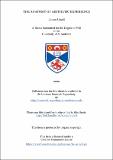Files in this item
The anatomy of aesthetic experience
Item metadata
| dc.contributor.advisor | Gaut, Berys Nigel | |
| dc.contributor.author | Ursell, James | |
| dc.coverage.spatial | 176 p. | en_US |
| dc.date.accessioned | 2020-02-20T14:28:16Z | |
| dc.date.available | 2020-02-20T14:28:16Z | |
| dc.date.issued | 2020-06-22 | |
| dc.identifier.uri | https://hdl.handle.net/10023/19508 | |
| dc.description.abstract | The primary aim of this thesis is to formulate an intensional definition of aesthetic experience. Its secondary aims are (i) to show how this definition might be used for empirical research and (ii) to better understand other terms that are qualified by ‘aesthetic’ (chiefly, ‘aesthetic properties’ and ‘aesthetic value’). In chapter one, I will explain the nature of the problem we face and why it demands our attention. In chapters two and three, I will critically survey positions in the literature and argue that none adequately characterise aesthetic experience. In chapter four, I will motivate and defend an intensional definition of ‘aesthetic experience’ and an art-based account of ‘aesthetic properties’. The former states, put briefly, that aesthetic experiences are those which acquire a valence when the subject attends to the content of her experience for its own sake and discerns aesthetic properties. The latter states that ‘aesthetic properties’ are those which comprise the value artworks have as works of art. In chapter five, I will use this definition of aesthetic experience to formulate the hypothesis that mindfulness training can augment one’s propensity for having rewarding aesthetic experiences of nature and everyday life. I will then propose how this hypothesis could be empirically investigated. In chapter six, I conclude by examining what my analysis of ‘aesthetic experience’ and ‘aesthetic properties’ reveals about ‘aesthetic value’. I will then, finally, highlight topics requiring further research. | en_US |
| dc.language.iso | en | en_US |
| dc.publisher | University of St Andrews | |
| dc.rights | Creative Commons Attribution-NonCommercial-NoDerivatives 4.0 International | * |
| dc.rights.uri | http://creativecommons.org/licenses/by-nc-nd/4.0/ | * |
| dc.subject | Aesthetics | en_US |
| dc.subject | Aesthetic experience | en_US |
| dc.subject | Aesthetic properties | en_US |
| dc.subject | Aesthetic value | en_US |
| dc.subject | Mindfulness | en_US |
| dc.subject | Meta-aesthetics | en_US |
| dc.subject | Noël Carroll | en_US |
| dc.subject | Robert Stecker | en_US |
| dc.subject | Gary Iseminger | en_US |
| dc.subject | Jerrold Levinson | en_US |
| dc.subject | Clive Bell | en_US |
| dc.subject | Monroe Beardsley | en_US |
| dc.subject | Edward Bullough | en_US |
| dc.subject | Jerome Stolnitz | en_US |
| dc.subject | Bence Nanay | en_US |
| dc.subject | Well-being | en_US |
| dc.subject.lcc | BH39.U8 | |
| dc.subject.lcsh | Aesthetics | en |
| dc.subject.lcsh | Mindfulness (Psychology) | en |
| dc.title | The anatomy of aesthetic experience | en_US |
| dc.type | Thesis | en_US |
| dc.contributor.sponsor | University of St Andrews. School of Philosophical, Anthropological and Film Studies | en_US |
| dc.type.qualificationlevel | Doctoral | en_US |
| dc.type.qualificationname | PhD Doctor of Philosophy | en_US |
| dc.publisher.institution | The University of St Andrews | en_US |
| dc.identifier.doi | https://doi.org/10.17630/10023-19508 |
The following licence files are associated with this item:
This item appears in the following Collection(s)
Except where otherwise noted within the work, this item's licence for re-use is described as Creative Commons Attribution-NonCommercial-NoDerivatives 4.0 International
Items in the St Andrews Research Repository are protected by copyright, with all rights reserved, unless otherwise indicated.


